This was published 5 years ago
Sri Lanka: Why this is Lonely Planet's top destination for 2019
By Julietta Jameson
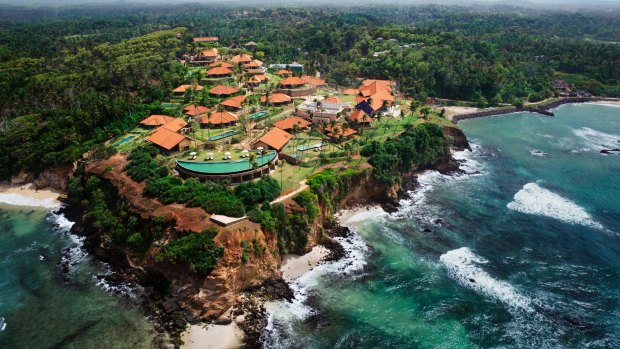
Resplendent Ceylon Sri Lanka.Credit: Tom Parker
It's 3.30am in Sri Lanka but my body clock says 7am, Melbourne time. High in this teardrop-shaped island nation's emerald tea country, I turn on the bedside lamp. Oh well, I may as well sit quietly reading amid the high thread-count linen – not a bad way to while away the wee hours. Through the billowy net enshrouding my four-poster bed, I spy it within arm's reach: the butler button. I glance at it and resist, several times, till dawn breaks, about six. Then I press. There's a gentle knock. "May I have my bed tea now?" I ask apologetically of the butler.
"Of course, madam," he says with a warm smile, then softly closes the door.
For the uninitiated, "bed tea" is, simply, tea in bed. This had been explained to me the night before when I, then still among the uninitiated, was asked what time I would like it. I had responded with a puzzled expression followed by a muffled squeal of delight belying a hoi polloi guilt when I grasped the concept. I ordered it for 7am, only I was thinking Sri Lanka – not Melbourne time.
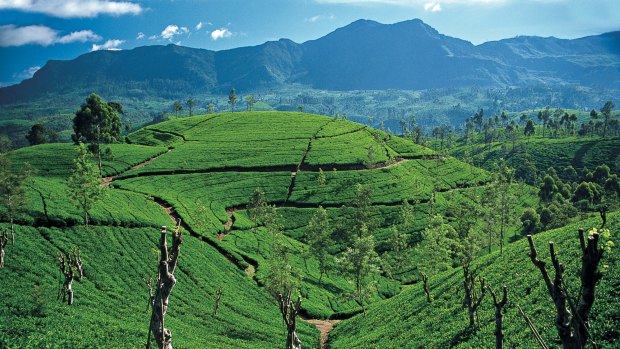
The increasingly popular Sri Lanka is expected to receive 3 million visitors annually by 2022.
The butler takes less than five minutes to return with a tray, and pours perfectly brewed, delicately perfumed tea into a fine china cup, which he delivers to me in my bed. At my request, he throws open the French doors to a private garden, from whence the first bird calls and heady fragrances of this exotic part of the world imbue my suite with more sensory delight.
Best cup of tea, ever.
Its accompaniments – attention to detail and service and the feeling of nothing being too much trouble – are the very epitome of the ethos that elevates this property, Ceylon Tea Trails to the truly extraordinary. That extends to the other two properties in the Resplendent Ceylon portfolio, which I am to experience over the next week: Wild Coast Tented Lodge at Yala National Park and the resort, Cape Weligama outside Galle.
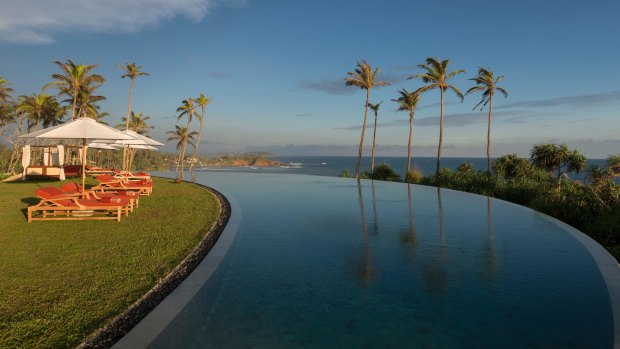
Cape Weligama has just about the most photogenic swimming pool in the world.Credit: Sebastian Posingis
Resplendent Ceylon is the hospitality concern of the Fernando family of Dilmah Tea fame. It is the sole Sri Lankan member of Relais et Chateaux, which tells you a bit more about the group: Relais et Chateaux only offers membership to establishments that combine great location choices, exemplary service, superlative accommodation and/or outstanding high-end dining.
But there's more going on here: a unique alchemy created by the grace, generosity and it must be said, impeccable taste of the Fernandos, their love and understanding of their country and their desire to put its best foot forward to visitors.
A COUNTRY ON THE RISE
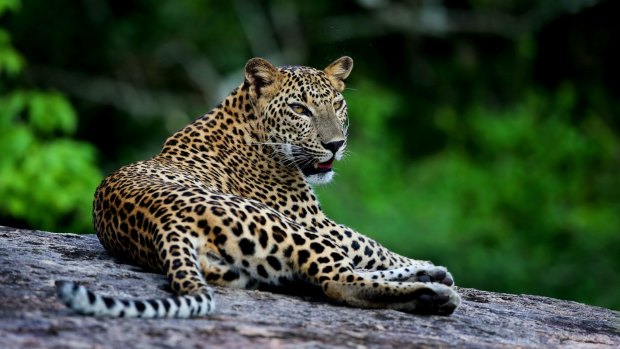
The elusive Sri Lankan leopard is the main attraction for most people heading out on safari.Credit: Tom Parker
Celebrating 70 years of independence, Sri Lanka has just been named Lonely Planet's Top Destination for 2019. It's a country of nine provinces including Central Province in the hill country; North Central Province with its concentration of ancient sites; the Western Province, home to the capital, Colombo; Northern Province, where the horrors of the 25-year civil war that raged as recently as 2009 were most felt; and Southern Province, where the 2004 Boxing Day tsunami hit – the wounds of which, like the war, now healed but not forgotten.
But the remnants of the English colonial years, when the country was called Ceylon, remain in language, architecture and industry. In the tea country, you see it in the original tea processing factories, where machines run on belt drives and light dapples across wooden floors.
They exist side by side with Buddhist temples and traditions that reach back thousands of years in a small, Indian Ocean island country that is blessed with an ever changing landscape running from elevated lush rainforests to white sand beaches. It's also blessed with beautiful people: friendly, polite, curious and welcoming.
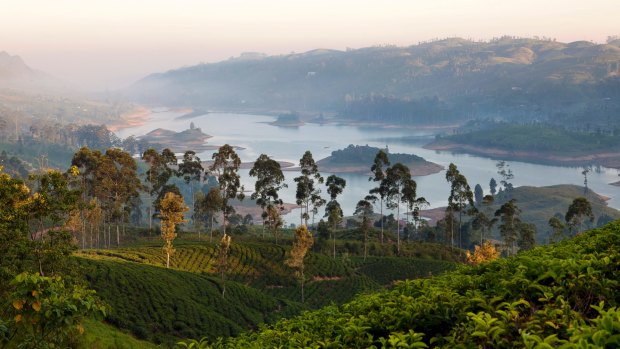
Sri Lanka is blessed with an ever changing landscape running from elevated lush rainforests to white sand beaches.Credit: Tom Parker
Getting around can be slow. Really slow. You'll hear the odd local or two lament the withdrawal of the British; "Things would be more developed now. Our roads would be better," they say. But it's those windy roads – where swarms of tuk-tuks (three-wheelers) battle with beeping buses and pushy trucks – that have largely preserved Sri Lanka's character and charm, a situation within which is the age-old dichotomy: charming for visitors, frustrating for locals. With new expressways and more under development change is afoot – and so too, a sense of "see it while you can".
Because as for tourism, Sri Lanka welcomed just over 1 million visitors in 2012 and more than 2 million in 2017 (with its close proximity to India, many come from the sub-continent). While that tally is expected to hit 3 million by 2022, 700,000 people visited in the first quarter of 2018, so the figure may be met earlier.
Backpackers and surfers can still do it cheap like the old days, though. Families, friends and couples can still find middle-of-the-road affordability in this children-loving, super friendly country. But now there's a burgeoning high end.
Add in Sri Lankan Airlines' direct service between Colombo and Melbourne and why wouldn't you consider such an intoxicating holiday prospect?
DRIVEN MAD
Well, perhaps because of the aforesaid roads. Having arrived on that direct flight at 10pm, I bunker in for the night at a boutique inn near the airport. The Wallawwa is an atmospheric colonial estate where my suite is huge, imaginatively appointed with a large fireplace, private plunge pool and garden. It just seems a great waste to be going to bed late and heading off immediately after breakfast.
But my driver picks me up at 10am for the 130-kilometre trip to Ceylon Tea Trails. It will take four hours, for a distance that, at home would take 90 minutes tops. It should be arduous but it's just so dazzling. We navigate skinny roads that wind through little villages and bustling towns where a kaleidoscope of goods hang in shop windows and children in neat white uniforms play in cheerful schoolyards. We pass along dramatic gorges with teeming rivers cutting a swath, through dripping jungle and by grazing oxen. Under rain so heavy it redefines "pouring". Under a sun that emerges after and makes everything sparkle golden. Past those pushy buses and trucks, in hair-raisingly close encounters.
And finally, we near our destination, among the hills of the Bogawantalawa region, in the central south of the country. This is real tea country, where prized "high grown" varieties flourish and teams of Tamil pickers in colourful saris dot the vertiginous slopes while diaphanous clouds crown the peaks above.
My accommodation is in one of a series of five impeccably refurbished historic plantation manager bungalows set in the slopes surrounding tranquil Castlereagh Reservoir. Old-time jazz emanates from the common lounge, dining and bar area that opens up to a terrace overlooking an infinity edge pool and the lake beyond. I'm just in time for afternoon tea alfresco. In fact, all guests in my bungalow – two couples, another solo traveller and I – eat every meal out there, at night seeing the smattering of lights glowing amber across the lake and the black hills against a deep blue sky.
I swim in that gorgeous pool, hike in the tea plantations (a surprisingly challenging exercise), ride a ferry across the lake for a tea factory tour, laugh with the charismatic staff who attend to every whim and need (including patching me up after a leech bite) and chat with the other guests, who are all of the adventurous, off-the-beaten-track kind of luxury seeker. My kind of people.
FROM MOUNTAIN TO COAST
A long drive: 120 kilometres south-east that takes four hours. But what a drive. We stop for a cup of tea at the hotel where the cast of David Lean's Oscar winner, Bridge on the River Kwai, stayed while the movie was shot along the jungle-lined Kelani River in the 1950s. I gaze out across wide white water rapids from the stilted restaurant with open sides that catch the cooling breeze, as a shyly smiling man keeps the floor shiny with a Hoover polisher from the same decade.
Finally reaching Tissamaharama, a town crowded with hotels, we are beckoned by jeep drivers parked along the roadside. "Safari, madam! Safari, madam!" they call. We are in the vicinity of Yala National Park.
My digs are at Wild Coast Tented Lodge, an extraordinary resort designed by Sri Lanka-based Nomadic Resorts, known for eco-conscious, organically shaped structures, and interiors by Amsterdam-based furniture designer Bo Reudler. It's all dome-shaped roofs formed by a woven bamboo skeleton clad in reclaimed teak shingles, glimmering natural crystal installations and an incredible curving swimming pool that snakes through public areas. Accommodation is in 28 "cocoon suites", spaceship-like white pods with porthole windows grouped around watering holes, designed to entice adjacent Yala National Park's animals. There are no fences to speak of and a huge expanse of untamed beach where wildlife roams. My suite is one with a deck and private pool (where elephants sometimes drink) near the dunes. I have a freestanding handmade copper bathtub, a four-poster bed and furnishings that evoke colonial safaris.
Sri Lankans love food. Meal time here is an extreme sport: big Sri Lankan breakfasts, sumptuous dinners with excellent wine choices, long lunches, all to the sound of crashing waves, singing birds or chirruping critters. One lunchtime, I try to leave the dining hall without dessert. The chef stands sadly watching me leave. "It was wonderful, honestly, I'm just full," I say, apologetically.
"But madam, I made it especially for you."
"Oh, well, just a bite, then." Back to the table I go.
Safari is also a serious pursuit here. Each morning and afternoon, hundreds of safari vehicles converge on the national park. So in the morning, we set off at 4.30am to ensure we're in the front of the queue when the gates open at six. In the afternoon, we head off to less touristy parts of the park, with the getting there – down dirt tracks that pass through traditional villages – so much of the fun. That illusive Sri Lankan leopard is the main attraction for many, but the park is home to deer, sloth bears, elephants, monkeys, peacocks and other beautiful birds.
ON THE ROAD AGAIN
The longest drive of all is from Yala on the west coast to Galle on the south-east. It's 150-or-so kilometres as the crow (or helicopter transfer) flies, and additional by road. The country changes from the dryness around Yala to rice paddies and faded pastel villages with small stores selling fruit and rubber balls. The driver and I keep ourselves amused exchanging cultural stories and talk of cricket.
As we reach Galle, it's Friday afternoon peak hour and the traffic crawls along, which gives me an opportunity to admire the beaches and stilt fisherman doing their thing for the tourists and to talk to the driver about the recovery from the tsunami that hit so hard here.
Outside town is Cape Weligama. Here, my suite is the size of a not-modest house. These are the biggest hotel rooms in Sri Lanka and the bathroom, I think, is just about as big as my apartment. The space, though, isn't of the overwhelming kind. It's the kind that makes you exhale, from deep down, and relax.
And despite Cape Weligama having just about the most photogenic swimming pool in the world – its 60-metre crescent moon infinity version meeting sunsets across the ocean without interruption – there are another 13 on the property. For 39 rooms.
There's a family pool and villas are in small groups around their own 15-metre infinity edge version.
The public spaces are designed with nods to both traditional decor and colonial architecture. It's impossible to resist a gin and tonic in the Cape Club bar, or a Lion Lager in the relaxed Surf Bar, with its pared back, mid-century tiki decor.
And, ah, the food. The cuisine from east to west, constitutes destination dining, even discounting the phenomenal setting. And all of this, with incredible sea views every which way.
FORT HARD
I manage to extract myself, to tour wonderful Galle. Delightfully, cricket is being played, not only on the famed Galle International Stadium (it's more genteel country ground than stadium) but also on seemingly any available patch of grass around the majestic fort, first built by the Portuguese in the 1500s and extended by the Dutch. (Oh yes, with such a position on the Silk Road, the English were not the only interlopers.) I go to haggle for gems (and talk cricket) at a reputable dealer, to buy presents at the unmissable local crafts and textile emporium, Barefoot Gallery and stroll the bustling general market where families shop for food. Galle and surrounds offers much to do. At Cape Weligama, an onsite adventure centre hosts bike and horse riding and all manner of water sports.
The night before my airport transfer is scheduled to pick me up, I'm sitting, on my own, on a little outcrop that's down some hidden stairs beside Cape Weligama's main pool. A waiter arrives with my G&T. Ice tinkles. Birds call their goodnight. Waves sound the redolence of a calm sea meeting the shore below me. I'm watching the kind of epic sunset over the ocean that I think should be painted.
And then it occurs to me: Sri Lanka is a place that paints an impression on your soul. Its colours, moods, tastes, smells, its wonderful people; they leave an indelible mark.
Yes, tomorrow I'll be making another long road trip, this time to Colombo for my flight home, but this is an impression that will be coming with me, and last a lifetime.
TRIP NOTES
STAY
Resplendent Ceylon offers a number of package combinations that include one or all three properties. Or, you can tailor a stay to suit your plans.
For instance, a minimum two-night, fully inclusive stay at Ceylon Tea Trails with factory tour and Dilmah gift box among other inclusions is from $US1866 a night.
There are five nights for the price of four at Cape Weligama with breakfast and one dinner included – $2375 for five nights for two till December 15.
A fully inclusive rate at Wild Coast Tented Lodge with daily game drive, monastery visit, and nature walk with a minimum two-night stay is $US1608.
The Wallawwa is in Kotugoda, nine kilometres from the airport. See mrandmrssmith.com
FLY
Sri Lankan Airlines flies direct Melbourne to Colombo and return daily. Business class fares come with a dedicated "silk route" check in. Prices from $870. See srilankan.com
MORE
Julietta Jameson travelled a guest of Resplendent Ceylon and Sri Lankan Airlines. She stayed at The Wallawwa at her own expense.
Five more things to do and see
1.POLONNARUWA
Walk the Buddhist temples, monasteries and monuments of the ancient capital in North Central Province. World Heritage-listed and dating back to the 11th century, it is one of Sri Lanka's finest archaeological sites.
2.SIGIRIYA
An ancient rock fortress designed in the shape of a lion, Sigiriya rises 200 metres above the surrounding landscape, where there are remnants of landscaping and fortifications dating to the third century BC. The view from the top is breath-taking – as is the steep ascent.
See also: Two-hundred-metre high rock: Asia's own version of Uluru
3. TEMPLE OF THE TOOTH
In the heart of tea country, enjoy the cool climate and visit the Temple of the Tooth, home to Sri Lanka's most important Buddhist relic. The temple complex itself is beautiful – and often crowded.
4. TAKE THE TRAIN
Sri Lanka's trains are a cheap, and relatively stress-free way to travel between destinations. Some colonial railway stations are highly photogenic, as is the scenery en route. Going east from Colombo to the Hill Country, the views put it on many a list of the world's best train rides. See railway.gov.lk
5. PERADENIYA ROYAL BOTANIC GARDENS
If you love orchids, don't miss the glorious gardens in Kandy. The colonial spread (though gardens have been here since the 1300s) on the banks of the River Mahaweli runs to 60 hectares with lovely avenues, plantations and an artificial lake.
Five dishes you must try in Sri Lanka
1.FISH AMBUL THIYAL (SOUR FISH CURRY)
Sri Lankan seafood is fantastic and of all the different fish curries this is perhaps the most ubiquitous – and delicious. Spices such as cinnamon, turmeric and garlic cradle the dried goraka, which adds sourness.
2.KOTTU
The local version of roti bread, sliced and fried to oily perfection. Look for street vendors who attract a crowd.
3.STRING HOPPERS
A pancake of rice flour and coconut milk, best enjoyed with chilli and onion sambals. You'll see them on the breakfast table – don't hesitate to try.
4.WOOD APPLE
The smell is kind of odd, it looks weird, but this peculiar fruit is a favourite at local markets. A great way to sample wood apple is in a smoothie.
5.DHAL
Another great breakfast dish, though served any time, Sri Lankan dhal has a coconut milk base. The more chilli, the better.
Sign up for the Traveller Deals newsletter
Get exclusive travel deals delivered straight to your inbox. Sign up now.